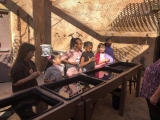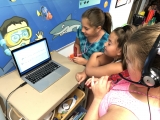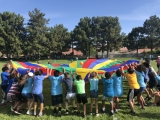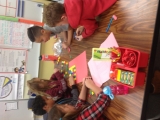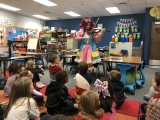-
Category 1
Selected in 2020
-
Grades: pre k - 5
School Setting: suburban
Town Population: 330
Student Enrollment: 452
Student Demographics:
Black/African American: 13.7%
Teacher/Student Ratio: 1:22
White/Caucasian: 32.5%
Hispanic: 40%
Hawaiian/Pacific Islander: 2.4%
Asian: 1.5%
Native American: 0.7%
Other: 0%
% Reduced Lunch: 64.1%
% ELL Learners: 4.4%
Founded: 1987 -
PRINCIPAL:
Darla Richards -
CONTACT:
1831 Fox Ridge Drive
Henderson, NV 89014
702-799-7788
richadd@nv.ccsd.net
Estes McDoniel Elementary School
Henderson, NV
- Describe the most successful activity your school has initiated to strengthen ties to your community.
- Describe your philosophy of school change or improvement.
-
Research shows that teacher effectiveness is the single most important school-based factor in student success. Students who have highly effective teachers for three years in a row will score 50 percentile points higher on achievement tests than students who have less effective teachers for three years in a row. Placing an effective teacher in every classroom is a priority at McDoniel Elementary School! Effective teachers regularly collaborate with other teachers, administrators, parents, and educational professionals to ensure students' success, particularly the success of students with special needs. Our teachers also contribute to positive academic, attitudinal, and social outcomes for students such as regular attendance, self-efficacy, and cooperative behavior through the relationships they create with their students. Teachers set high expectations for all students and use diverse resources to plan and structure engaging learning opportunities. Teachers at McDoniel Elementary are engaging teachers who motivate learning on a daily basis!
- What is the single most important factor in the success of your school that others could replicate?
-
At Estes McDoniel, we believe that early intervention is the main factor in our success. We use systematic screening and diagnostic assessments to determine our students who are at risk of meeting grade level standards. Within the first two weeks of school, or within the first week of a student’s late enrollment, we have identified the students who are not on grade level and have diagnosed the problem area or the holes in learning. We work as a team with our literacy strategist, grade level teachers, and certified temporary tutors to fill in those gaps as soon as possible. Individual students are often serviced one-on-one with a teacher to fast track that learning process and to tailor the instruction to meet that individual student’s needs. Our early intervention process promotes immediate intervention as soon as students’ reading problems are revealed, which in turn, prevents substantial reading difficulties from developing. Research has shown that students who have difficulty learning to read are unlikely to catch up with their peers without early, intensive, and effective interventions. Many of these students do not receive the intensive instruction they require until later in the intermediate grades; We do everything in our power to prevent that from happening at Estes McDoniel.
- Describe the program or initiative that has had the greatest positive effect on student achievement, including closing achievement or opportunity gaps, if applicable.
-
Estes McDoniel has implemented designated mandatory PLCs (Professional Learning Communities) which we believe has had the greatest positive impact on growth and student achievement. Our PLC model gives us a framework to form high-performing, collaborative teams of teachers that are all united toward the improvement of student learning. During PLC team meetings, teachers share their concerns, reflect on their teaching strategies, and make decisions based on data. The four critical questions of the PLC model that drive the conversations of grade-level meetings are: What do we want students to learn? (Planning and pacing instruction) How will we know if they have learned it? (Collect data) What do we do if they do not learn it? (Intervention) What do we do if they do learn it? (Enrichment) We designate two hours per week to focus on these four questions and group our students to differentiate our instruction. Teachers create common assessments and decide on grade level expectations on mastery of grade level standards. Our academic growth has improved tremendously since we have implemented this model.
- Describe how data is used to improve student achievement and inform decision making.
-
Estes McDoniel uses a wide range of assessments to analyze data to improve student achievement and to help us make critical decisions on curriculum, differentiated instructional groups, and instructional strategies. No single assessment can tell educators all they need to know to make well-informed instructional decisions. Our annual statewide accountability test (SBAC), benchmark assessments, and early-grade reading assessments, administered at multiple points throughout the school year, provide feedback on student learning which helps teachers focus on specific learning goals. Teachers collaboratively create assessments that are administered consistently and routinely to provide information that can be compared across classrooms. We use the data for school management purposes, rewarding teacher performance, and determining appropriate ways to schedule the school day. Estes McDoniel collects data on students’ attendance, behavior, activities, curriculum, and grades, as well as a range of administrative data concerning staffing, scheduling, and financing. We often collect data from surveys or focus groups with students, teachers, parents, or community members. The use of this data has been used to help inform instructional decision making which directly impacts student achievement.
- Describe your school culture and explain changes you’ve taken to improve it.
-
My priority as principal of Estes McDoniel Elementary was to start the process of improving our school culture. Serving previously as the assistant principal, I was able to analyze the current climate of our school. I felt it was crucial to take time to listen to feedback from teachers, students, and parents in order to understand the experience that they were having at McDoniel. I wanted to keep the specific factors that indicate a positive school culture and work as a team to take decisive action to remove those negative aspects. We have created an environment that generates clear, open communication with the staff and parents of our students which has developed a “We are all in this together” feeling which developed trust and has helped avoid misunderstandings. McDoniel loves to celebrate successes! The school day (and school year) are punctuated with time for celebrations. We celebrate the student’s achievements and the successes of our teachers and staff. This helps staff and students engage with each other in positive events and builds morale in school. Teachers are encouraged to try new methods of teaching and work together in regular scheduled PLCs to share ideas. Even the physical surroundings of Estes McDoniel have a huge impact on the positive culture of our school. Teachers have the freedom to paint walls and use flexible seating in classrooms which creates higher levels of productivity and collaboration.
Stats
-
Category 1
Selected in 2020
-
Grades: pre k - 5
School Setting: suburban
Town Population: 330
Student Enrollment: 452
Student Demographics:
Black/African American: 13.7%
Teacher/Student Ratio: 1:22
White/Caucasian: 32.5%
Hispanic: 40%
Hawaiian/Pacific Islander: 2.4%
Asian: 1.5%
Native American: 0.7%
Other: 0%
% Reduced Lunch: 64.1%
% ELL Learners: 4.4%
Founded: 1987 -
PRINCIPAL:
Darla Richards -
CONTACT:
1831 Fox Ridge Drive
Henderson, NV 89014
702-799-7788
richadd@nv.ccsd.net




